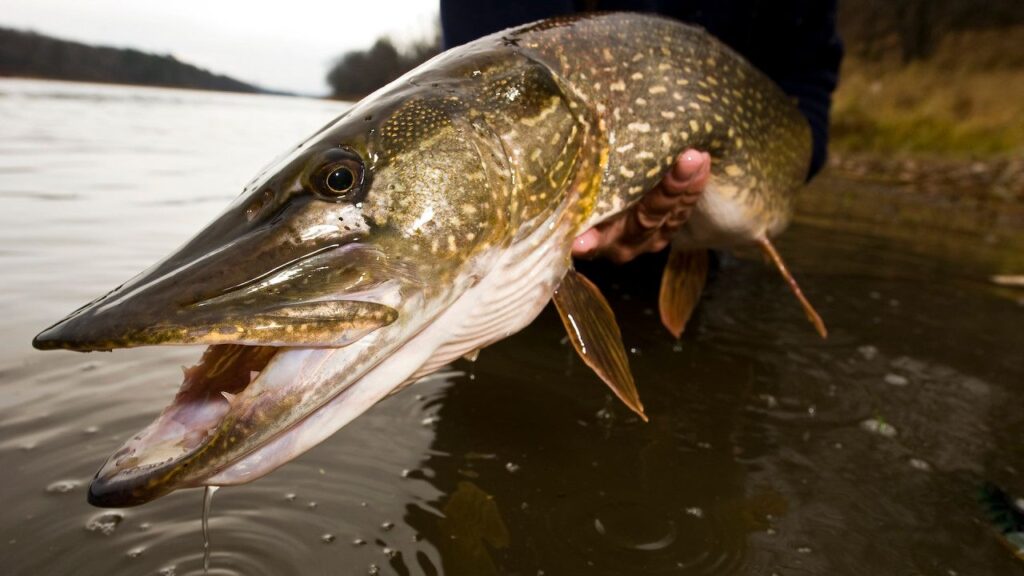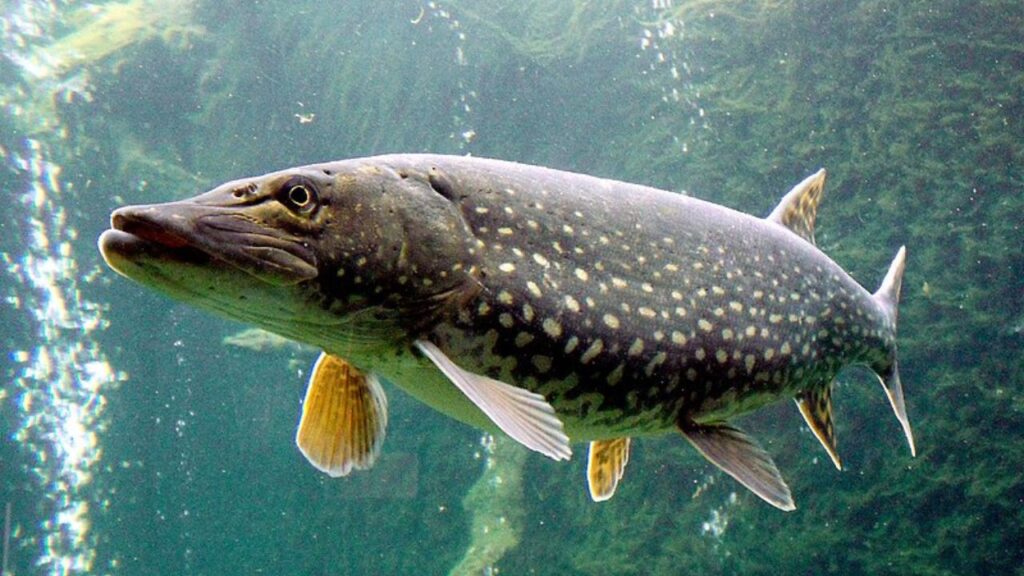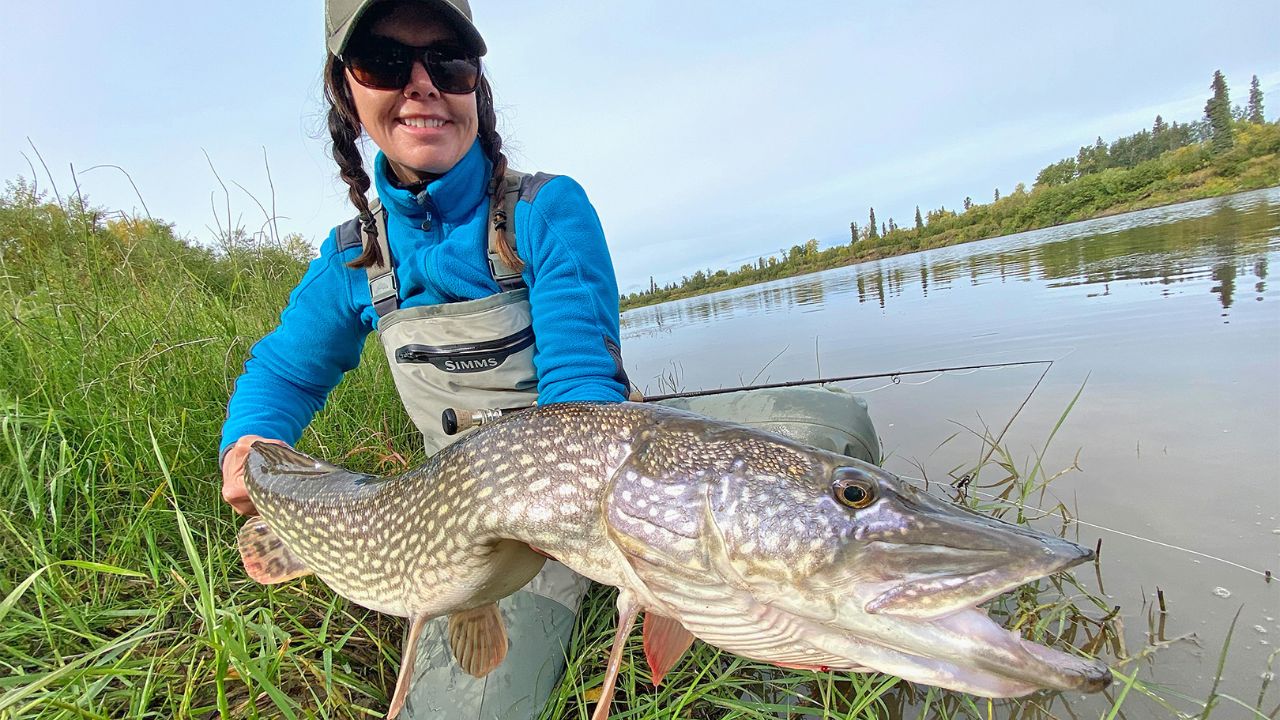Do Pike Attack Humans? Pike are known to be aggressive predators, but attacks on humans are extremely rare and usually accidental.
Pike are fascinating freshwater predators known for their elongated bodies, sharp teeth, and voracious appetite.
These fish are among the top predators in their aquatic environments, which naturally leads to questions about their interactions with humans.
Do pike attack humans? Are these fish as dangerous as their reputation suggests?
This blog post explores the facts, myths, and realities surrounding pike attacks on humans, diving deep into their behavior, notable incidents, and how to stay safe around them.
Contents
What Are Pike?
Appearance and Characteristics of Pike
Pike are large, freshwater fish characterized by their long bodies, pointed snouts, and sharp, needle-like teeth.
Their bodies are typically olive green with light-colored spots, allowing them to blend seamlessly with their surroundings.
Pike can grow to impressive lengths, with some reaching over four feet and weighing more than 50 pounds.
The largest pike on record, caught in Germany, weighed over 55 pounds and measured nearly five feet. [Do Pike Attack Humans?]
Known for their predatory nature, they often ambush their prey with speed and precision, making them a favorite among sport anglers for their challenging fight.
Habitat and Behavior
Pike are commonly found in freshwater lakes, rivers, and streams throughout the Northern Hemisphere, particularly in North America, Europe, and parts of Asia.
They prefer areas with plenty of vegetation, such as weed beds and reed-filled shallows, which provide cover for ambushing prey.
Pike are solitary hunters, feeding primarily on smaller fish, but they can also eat amphibians, waterfowl, and even small mammals.
Their aggressive behavior and keen hunting instincts have earned them a fearsome reputation, and they are often regarded as “water wolves” due to their predatory nature.
Do Pike Attack Humans?
Rarity of Pike Attacks on Humans
Pike attacks on humans are exceedingly rare, and there is little evidence to suggest that pike pose a significant threat to people.
While pike are known for their aggressive nature toward their prey, there are very few documented cases of them attacking people.
Most encounters with pike are accidental and result from the fish mistaking a human limb for prey or reacting defensively when handled.
In reality, pike do not actively seek out humans and are more likely to flee than attack when approached. [Do Pike Attack Humans?]
Pike prefer to conserve their energy for hunting smaller prey, and humans are far too large to be considered a food source.
Reasons for Pike “Attacks” or Bites
There are a few reasons why a pike might bite a human, but these are almost always cases of mistaken identity or defensive actions.
One of the most common reasons is mistaken identity. When swimming or wading in water, pike may confuse a hand, foot, or finger for a smaller fish or other prey, especially if there is rapid movement that resembles the fluttering of a fish.
Another reason could be defensive behavior; if a pike feels threatened, cornered, or captured, it may bite as a means of self-defense.
Anglers handling pike without caution are particularly at risk of bites due to the fish’s sharp teeth and powerful jaws.

Behavioral Triggers Leading to Attacks
Certain behaviors and situations can trigger aggressive responses from pike. For example, rapid or splashing movements in the water may mimic the behavior of distressed prey, attracting a pike’s attention.
This is especially true in areas where pike are used to feeding on fish that dart and move quickly. Additionally, bright or shiny objects, such as jewelry, watches, or fishing lures, can provoke a bite.
A pike’s keen eyesight is adapted to detect movement and reflective surfaces, which can resemble the scales of a fish.
It’s important to note that these triggers do not guarantee an attack but can increase the likelihood of an encounter. [Do Pike Attack Humans?]
Myths and Misconceptions About Pike Attacks
There are several myths and misconceptions surrounding pike and their aggression toward humans. [Do Pike Attack Humans?]
One common myth is that pike are naturally aggressive toward humans and will attack them without provocation. In reality, pike are not inherently dangerous to humans and are more focused on their natural prey.
Most “attacks” are simply cases of mistaken identity or defensive reactions. Another misconception is that pike are territorial and will aggressively defend their space against humans.
While pike are territorial towards other fish, they generally avoid humans, who are much larger and not seen as a direct threat or competitor.
Understanding Pike’s Natural Instincts
Pike are opportunistic predators with a natural instinct to hunt anything that fits in their mouth. Their sharp teeth, strong jaws, and quick reflexes make them formidable hunters in their ecosystem.
However, these instincts are geared towards catching prey like fish, amphibians, and small animals, not humans.
When a pike “attacks” or bites a human, it is usually out of confusion rather than a predatory drive. [Do Pike Attack Humans?]
Understanding these instincts helps demystify why pike might occasionally bite but also clarifies that they do not pose a significant threat to human safety.
Notable Pike Attack Incidents
Recorded Incidents of Pike Bites
Though rare, there have been some documented incidents where pike have bitten humans. One notable case involved a child swimming in a lake in Minnesota, where a pike reportedly bit the child’s foot.
The bite resulted in several puncture wounds but was not life-threatening. Another case occurred in Europe, where a swimmer felt a sharp pain and later discovered bite marks consistent with a pike’s teeth.
These cases are exceptional rather than the norm and often involve unique circumstances, such as swimming near feeding or nesting grounds.
Analyzing the Circumstances
When examining these incidents, a few common factors emerge. Most bites occurred in shallow waters where pike were hunting or in areas where anglers were actively fishing and handling pike.
In nearly all cases, the pike were likely acting out of confusion, self-defense, or were provoked. Pike are solitary and ambush predators; they do not pursue or target humans as a food source.
Understanding these circumstances helps highlight that pike attacks are not a major concern for most water activities, and the risk remains minimal.

Are Pike Attacks Dangerous?
Severity of Pike Bites
Pike bites can be painful due to their sharp teeth and the force of their jaws, but they are rarely life-threatening. [Do Pike Attack Humans?]
The severity of a bite usually depends on the size of the pike and the location of the bite. Most injuries from pike bites are minor and consist of cuts, puncture wounds, or scratches, which can be easily treated with first aid.
However, larger pike can deliver deeper wounds, which may require medical attention, especially if the bite involves sensitive areas such as the fingers, toes, or face.
Health Risks Associated with Pike Bites
While pike bites are generally not dangerous, there are potential health risks associated with any wound inflicted by an animal. [Do Pike Attack Humans?]
These include the risk of infection from bacteria present in the water or the pike’s mouth. In freshwater environments, bacteria such as Aeromonas and Pseudomonas can be present, posing a risk of infection if a bite is not properly cleaned.
Proper wound care, such as cleaning the bite thoroughly with clean water and antiseptic, is essential to prevent complications. In some cases, a tetanus shot or antibiotics may be recommended by healthcare professionals.
How to Avoid Pike Encounters
Tips for Swimmers
For swimmers in waters where pike are known to live, it is advisable to avoid splashing excessively or wearing shiny jewelry that could attract a curious pike.
Swimmers should stay aware of their surroundings and avoid areas with dense vegetation or where pike are known to feed.
Wearing water shoes can also help reduce the risk of injury from a curious bite, as well as protect against other underwater hazards.
Advice for Anglers and Fishermen
Anglers are at a higher risk of pike bites due to the nature of their activity. It’s crucial to use appropriate tools, such as fish grippers or pliers, when handling pike to avoid putting hands near the fish’s sharp teeth.
Wearing protective gloves and keeping fingers away from the pike’s mouth are also effective measures to avoid bites.
Additionally, handling pike carefully and quickly releasing them back into the water reduces stress on the fish and minimizes the chances of defensive biting.
General Safety Measures
Being mindful of the environment and respecting the natural habitats of pike can go a long way in preventing encounters.
Observing local guidelines for swimming, fishing, and interacting with wildlife is essential for both safety and conservation. [Do Pike Attack Humans?]
Avoiding known spawning areas, where pike may be more aggressive, is also a practical safety measure. Remember that pike, like all wildlife, are an important part of the ecosystem and should be respected as such.
Final Verdict
While pike are aggressive predators in their natural environment, they do not pose a significant threat to humans.
The chances of a pike attack are minimal, and most encounters are due to mistaken identity or defensive behavior.
Understanding their behavior and the context of these encounters can help alleviate fears about swimming or fishing in waters inhabited by pike.
In conclusion, pike are fascinating but misunderstood creatures. They are essential predators in their ecosystems, controlling the population of smaller fish and maintaining balance.
While their sharp teeth and aggressive hunting style may seem intimidating, pike are not interested in humans as prey. [Do Pike Attack Humans?]
Understanding their behavior and taking simple precautions can help ensure that any encounters with pike are safe and enjoyable.
See Also: Do Dingoes Attack Humans? Understanding the Risks!
FAQs
Are Pike Aggressive Toward Humans?
Pike are not typically aggressive toward humans and prefer to avoid them. Most encounters occur out of confusion or self-defense.
What Should You Do If a Pike Bites You?
Clean the wound thoroughly with clean water, apply antiseptic, and seek medical attention if needed. Monitor for signs of infection.
Are Pike More Dangerous During Certain Seasons?
Pike may be more aggressive during spawning season, typically in spring, but are still unlikely to attack humans. [Do Pike Attack Humans?]
Can Pike Attack Pets or Small Animals?
Pike may attack small animals or pets swimming in their territory, mistaking them for prey, especially if they move erratically.
What Is the Largest Pike Ever Recorded?
The largest pike ever recorded weighed over 55 pounds and was caught in Germany. Pike of this size are rare but highlight their impressive predatory capabilities.
Conclusion: Do Pike Attack Humans?
Pike are formidable freshwater predators but are not a significant threat to humans.
Understanding their natural behavior, the rarity of attacks, and how to prevent unwanted encounters can help people coexist safely with these fascinating fish.
When enjoying time in or near freshwater bodies, respecting nature and being aware of the wildlife around you can lead to safe and positive experiences with creatures like the pike.
Awareness, education, and respect are key to maintaining harmony between humans and wildlife. [Do Pike Attack Humans?]

Hello, I am Rosa Ellis, a mother of two and a wildlife blogger. I grew up in New York City, but I love exploring forests. I’ve traveled to places like Yellowstone National Park and the Amazon Rainforest to see animals up close. I know a lot about animal behavior and which animals can be dangerous to humans. Thanks for visiting my blog!

